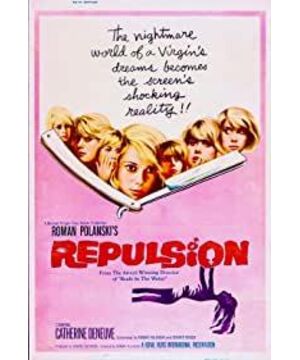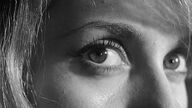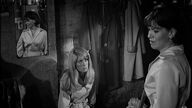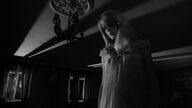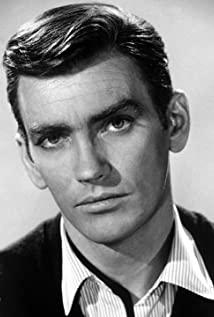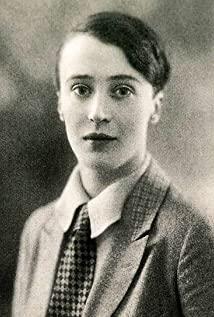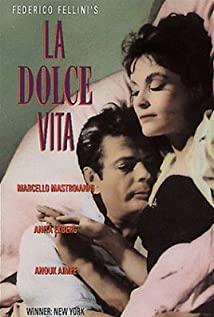"Cold Blood" is Roman Polanski's first English film and the second feature film. Polanski seems to have poured his vigorous creativity and volcanic eruption into the film, making a psychological thriller that is still chilling today. The film’s artistic achievements are mainly reflected in the dense and weird array of symbols, the extremely oppressive audio-visual language and the expressive performance of Catherine Deneuve. 1. Dense symbolic network and psychoanalysis Looking at Polanski's work sequence, the dark side of human nature and confined space are the two most frequently occurring motifs. In terms of exploring the instability of the spirit, "Cold Blood" followed by "Rosemary's Baby" (1968) and "Strange Tenants" (1976) constitute a slightly loose trilogy. All three films set the main space in the apartment. The similarities between "Cold-Blooded Cry" and "Strange Tenants" are the highest: both films show the process of lonely people gradually moving towards schizophrenia after being stimulated by a specific environment. The surreal imagery is also in the same line as the fierce and crazy audio-visual performance (they also have scenes where everyone is watching at the end). The concise and cold decoration style and cramped space of modern apartments have become metaphors for the protagonist's repressed spiritual world to some extent. Furthermore, the environment outside the apartment also reflects the heroine's soul on the verge of collapse. Every time Carol (Catherine Deneuve) goes out to the streets, the scope of road construction expands, and the stacked bricks are as disorderly as his heart.
The first scene after the opening of the film was Carol building nails for customers applying facial masks in a beauty salon. Here, the mask, as a symbol of concealment and diaphragm, indirectly refers to Carol's closed self to the outside world, and also shows her repression and resistance to her own desires. Of course, on the narrative level, the unique covering shape of the mask also played a role in frightening the audience and enhancing concentration. The contradictory entanglement between sexual depression/anti-male fear and instinctive sexual impulse is the main factor that pushed Carol into the abyss of schizophrenia. Therefore, most of the symbols in this film naturally tend to be placed in psychoanalysis about sexual suggestion. Interpretation in the network. The most obvious signs include Bridget’s cry to Carol that “men are dirty things”, and the “slut” that street women cried out to her inexplicably when Carol went out for the last time. In addition, when Carol received an unknown harassing call (according to the context, it can be inferred that the caller was the partner of Carol’s sister’s boyfriend), there was a heavy gasp in the receiver, which can also be regarded as a sexual desire. Implied with sexual depression. Carol rushed into the elevator after being forced to kiss by Colin who was pursuing him, rubbing his lips with his hands irritably, and brushing his teeth and gargle fiercely after returning home, showing his fear and aversion to contact with men. The meaning of the other set of action codes is slightly ambiguous: Carol picked up the vest on the floor in the bathroom and was about to throw it into the trash can. After hesitating for a while, he slowly took the dirty clothes to his mouth and smelled it. , Immediately dropped it, rushed to the sink and retched. The previous night, after having sex with her boyfriend, her sister entered Carol's room with a bath towel and questioned her behavior of throwing away her boyfriend's toothbrush. It can be seen that the vest should be contaminated with the body odor of the two. Carol’s behavior can be readable as yearning for the body of his sister (not without the lesbian meaning), but after smelling the man’s breath, he became disgusted. reaction. "Cold-Blooded Horror" repeatedly shows Carol's nightmare (or fantasy) of being sexually assaulted, and as her (at least in behavior) hatred of men gradually deepens, her long-repressed sexual desire is like surging magma. Like bursting out. After killing Colin who came to visit, she walked through the corridor of her home and was touched and molested by the clusters of arms growing out of the two walls. On the second night after hacking to death the landlord who tried to assault her, Carol deliberately put on lipstick, went to bed and waited for the man who came to rape her (fantasy) every night on time. In this way, the film combines the heroine's sexual repression and sexual exclusion into a set of concomitant conflicts, which gradually escalate with the development of the plot, until it reaches the climax of the interweaving and juxtaposition of murder (death) and devotion (sex). One part of the film is played on the TV that my sister is driving The boxing match can be regarded as an allegation of violence. Although the live broadcast of the boxing match is not significant in the film, in Polanski’s feature film "The Knife in the Water" (1962), the broadcast of boxing matches on the radio continues to rise and gradually rises rapidly. The gradually increasing tension between the middle three persons complements each other.
The church is another symbol that cannot be ignored. Every day at midnight, it is the bell of the church that evokes Carol's dreams of sexual assault, and this church is located directly opposite the apartment. The nuns wearing white robes downstairs, in Carol's eyes, are nothing more than a group of pure and flawless angels, a pure land away from filthy men, which is beyond sight. The introduction of the symbolic codes of Catholicism and (caused by sexual indulgence) guilt (or nuns and lusts) has enriched the meaning network of the film.
The ubiquitous cracks and gaps are given two meanings in the film. First of all, the cracks on the sidewalk are in the same scene as the road construction, and the collapsed ceiling above Carol's head at the end of the film symbolizes the disintegration and overturning of Carol's spiritual world. In addition, cracks also refer to women's vaginas. It is easy for us to think of another classic film depicting female mental patients—Ingmar Bergman's "Still in the Mirror" (1961). The heroine Karen often faces the cracks in the wall, giving birth to devout religious conjectures, and at the end of the film, God finally appears to her-a spider trying to rape her. In this film, the man who rapes Carol in the fantasy often appears from a crack in the bedroom wall. Coincidentally, Carol sat on a roadside bench, staring at the crack in a daze, while Colin, who was struggling to pursue her, stepped directly on the crack, forming a picture alluding to the two having sex. In addition, the razor that appears repeatedly in the film is also a typical symbol of male sexual organs in psychoanalysis (consider Carol throwing away the razor of his sister and boyfriend). Similarly, it also includes nail clippers that cut the skin, which is also sexual. What needs to be explained is that the author is opposed to the critical strategy of "any symbolic analysis is all argumentative". However, in the context of the film’s text, the above interpretation is by no means a far-fetched over-interpretation. In the mid-1960s when the film was completed, Freud’s psychoanalysis was prevalent, regardless of whether it was in art films (such as Ferry). This is true in Ni’s "Eight and a half" (1963), "Juliet and the Devil" (1965)) and commercial films (Hitchcock's "Mentally Ill" (1960)), and "Cold Blood Horror" is no exception. The other list of symbols is related to food (the so-called "food lust"). In the film, Carol’s colleague once described in detail “a hilarious Chaplin film that was screened the day before yesterday” (the audience who watched it would definitely be able to guess that this was "Gold Rush" (1925)): Chaplin was too hungry He ate the shoes as steaks and shoelaces as pasta; another person in the same group saw Chaplin as a fragrant chicken and ran after it. Immediately, a colleague found a heart in his handbag. In the film's meaning network, the food-induced hallucinations in "Gold Rush" are counterpointed by Carol's hallucinations caused by sexual desire. This is another brilliant stroke of Polanski.
In fact, Carol was consuming less and less food as he became mentally deranged. This can be seen from the untouched pile of potatoes and a plate of rabbit meat in Carol's home. Over time, the pile of potatoes began to sprout and rot. This imagery was reproduced in Polanski’s work "The Pianist" (2002) nearly 40 years later-the male protagonist played by Adrian Brody was trapped in the apartment, without water and food, and a serious mold appeared. The changed potatoes filled the hunger, leading to swelling of the liver, high fever, and almost death. As for the gradual quality and flies-growing rabbits, it is unavoidable to think of two nightmarish creatures in David Lynch’s "Rubber Head" (1977): the weird chicken wriggling on the dinner plate and the weird nausea. Deformed baby. It is almost certain that Lynch borrowed from this film to a certain extent. Another similarity between the two films is the presentation of the contradiction between sexual desire and sexual repression. However, Lynch’s story takes place entirely in a bizarre, post-industrial, apocalyptic surreal world, which is in line with the reality of the film’s time and space. The settings are quite different.
There is a small but striking flaw in the seemingly complete symbol system of "Cold Blood Horror", like a discordant note. Three artists on the road have appeared twice. One of them is playing the banjo, and the other two are facing opposite sides, hunched over, and shook an instrument similar to a sand hammer. There is nothing in the three people, without squinting, just like a bunch of detached existence. The deep meaning of this image cannot be accurately known, and the film's complete and dense symbol array is dyed with a touch of absurdity. According to Polanski himself (derived from the "Cold-Blooded Horror" DVD highlights part released by CC Corporation), he encountered the three by chance and felt that they were not meaningful, so he embedded them in the film. 2. Superb audio-visual language and acting skills Polanski once said in an interview that his main purpose of filming "Cold Blood Cry" is to earn enough funds to make the more personal film "Desert Island" that he really desires. Fright" (1966) (finally won the Berlin Golden Bear Award, and the film won the Silver Bear Award). Many critics believe that the film refers to real cases of mental illness and accurately shows the onset of mental patients and the symptoms of hallucinations, but the director is frank, he and another screenwriter, Gérard Brach (Gérard Brach) are just sitting The whole script came up in the hotel room. The content comes from improvisation, intuition, imagination and personal experience after taking hallucinogenic drugs. Nevertheless, film critics and audiences still can't help but admire Polanski's artistic accomplishments. A large part of this achievement is due to the film's exquisite audiovisual language and actors' performances.
In terms of camera scheduling, Polanski used a large number of sports long shots. The long shots used in the indoor paragraphs maintained the integrity of the space and increased the audience's sense of substitution. Outdoor street scenes are mainly hand-held follow-up shots. Carol in the lens is often presented in a close-up view from the side. The subtle facial expressions can be seen in full view. The shaking camera creates an atmosphere of confusion and anxiety. Many low-camera upside-down shots make the heroine always seem to be staring at the audience, surpassing the viewer, thereby increasing the film's tension. When Carol had hallucinations in the middle of the night, the low-angle shot of the cabinet made the bag and tennis racket on it appear to fall off at any time, which intensified the horror of the film.
The camera also has the function of distorting and transforming the movie space. After Carol murdered the intruder twice, the bathroom (with the corpse in the bathtub) and the living room (the corpse is hidden behind the overturned sofa) in the picture appear empty and large. This is a large depth of field produced by using a wide-angle lens. The effect, the depth of space is greatly exaggerated. When Carol lay on the bed and stared at the roof, the ceiling seemed to begin to fall, about to press on her. This visual effect is also created by the photographer through the zoom method (from the wide-angle to the telephoto lens quickly, not only the target is enlarged, but the depth of the picture is also sharply compressed).
The subjective lens is another effective way to create a sense of presence. Let me give you two examples. When Carol went out on the street for the first time, she met a man staring straight at her. When she passed by him, the camera stopped and fixed it to the man for a few seconds. In other words, the camera changed from the objective perspective of the handheld follower to the subjective point of view lens (it's easy to recall Murnau's "Sunrise"), but because the man's eyes continued to follow Carol, he looked out of the lens Therefore, this lens can be regarded as the subjective perspective of the camera, just as the camera suddenly possesses self-awareness and drifts away from the heroine, so a strange feeling permeates the viewer's heart. Another more conventional subjective shot is seen in the scene of Colin’s death: the picture is first presented as a three-person composition (Colin and Carol are on the left and right sides of the foreground, facing each other, while the back view is looking at the opposite door intently. To their old lady), the old lady opened the door and entered the house because the barking was found, Colin (to the back view) closed the door, and Carol ran towards him holding the candlestick high. Immediately switched to a subjective shot (Colin's) looking at the opposite door through a cat's eye. (Because Carol hit Colin in the space outside the painting) the camera jittered and moved down, and a blood stain appeared on the door panel. Immediately after the subjective shot of Colin fell to the ground, Carol continued to smash him on the head (in the eyes of the audience, it was like Carol smashed the camera/photographer). Here, the objective lens is transformed into two subjective scenes that are smoothly cut, forcing the audience to fully identify with Colin, and simulating the perception that the audience is also killed by the heroine, which is frightening.
The mirror also played a role in this film. Soon after the start of the film, Carol's distorted face was shown on the kettle, which foretells that her personal world is about to be distorted. Soon after her sister left, Carol opened the closet and was startled by the male suspect in the mirror of the cabinet door. It showed her fear and desire for men. It was after seeing this figure, Carol Er's hallucinations began to seep into reality. The sound processing of "Cold Blood" is also exemplary. Carol’s sexual assault fantasies were triggered by the sound of the church bell at midnight, and the hallucinations/nightmare afterwards were silenced. Carol’s silent roars and screams were only shown on the screen, and the only accompanying sound in the process was the clock. The ticking sound. The sign of the end of the nightmare is a deafening alarm or doorbell. Polanski used the method of silencer to distinguish the false from the real world, and at the same time created a different sense of "silence is better than sound at this time". And the superimposition of the midnight church bell and the ticking of the indoor clock appears as if a cave has opened the door to the world of the underworld, which is chilling (the sound effects are the same before Carol kills the landlord). In order to exaggerate the atmosphere of horror, the film makes use of sudden and terrifying high notes in many places, including alarms, doorbells, telephones, off-tune pianos, etc.: After Carol cuts the customer’s face, the customer’s screams and the unintended piercing high tones rise and fall one after another. , Interactive reverberation, irritating and horrifying; after Carol killed Colin, he looked at the corpse, and suddenly realized, after shouting, there was a sharp whistle and whistle; after the landlord was tortured, The rapid jazz drums burst into the eardrums, like an out-of-tune Requiem... The film was a great success, and Catherine Deneuve’s superb performance was indispensable. This French "ice beauty" showed a hairy indifference and cruelty, sometimes with dull eyes, like meditating, and sometimes hysterical like the sudden collapse of a snow-capped mountain. A similar performance style is also vividly reflected in another masterpiece "Beauty of the Day" (1967) starring Deneuve. In the film, Severina is in a trance, cold and silent on weekdays, but in the world of sexual fantasy, she is chasing ecstasy-like pleasure.
In order to show the heroine's neuroticism more vividly, Polanski designed a series of mechanical signs: Carol lay on the bed, listening to the sound of the bed next door, while chewing a bunch of his own hair; She wiped her sleeves like dust; a ray of sunlight shone into the room, and she hurriedly rubbed the stool with her hands, trying to drive away the light shining on it; she often made nervous wiping of her face or rubbing her arms. A series of "wiping" actions faintly reflected the magical shadow that lay in Carol's heart: the world is like a melting pot, evil qualities are stirred everywhere, and everything is dirty and dirty. After the murder, Carol became more and more deeply trapped in the mud of self-distorted time and space, humming a monotonous melody while threading needles and knitting sweaters aimlessly. The singing sounds like weeping but not weeping, sometimes trembling, sometimes changing the tone, which makes people shudder. And her humming and ironing of clothes with an unplugged iron, and the act of engraving incomprehensible text on the glass door also reflected that she had lost the ability to communicate with the real world.
The last shot of the film is very meaningful. In the darkness, the camera slowly moved to the right, and the furnishings, ornaments and clocks of Carol's house gradually appeared before our eyes, illuminated by a beam of light from an unknown source. Afterwards, the camera slowly moved down, passing by the TV, over the scattered bedding and balls of wool, looking down at the carpet, the postcard of the Leaning Tower of Pisa sent by my sister gradually became clear in the fading passive light. The black scene that followed ended this long shot. After a while, the camera panned to the left to the photo of Carol's family as a child, which had been emphasized several times before. Most of the photo is obscured by darkness, except for the young Carol in the background and the man in the front right. The little girl stood on her own, staring into the distance without complaining (the eyes partially coincide with the direction of the man), like a silent accusation against her family (possibly abusing or even assaulting her), but also like being addicted to her own kingdom forever Among. The shadow of the diamond shape constitutes a visual image of a prison, locking Carol tightly in it, with nowhere to escape. The lens is gradually pushed forward, zooming in, until the little girl’s pupils are close-up, so that the film has an image of Carol’s eyes (but the direction of the zoom push and pull is exactly the opposite of the film opening). This shot felt like a sigh of unmanned navigation, sour and melancholy, while the flute sound that echoed with the opening sounded sad and sad. At this moment, it seemed that all the disillusioned wounds were whizzing past, making it powerless. speech. 【All rights reserved, no reprinting】
For more movie recommendations, wonderful reviews and related sharing, please pay attention to the official account: Ice Red Dark Blue Movie
View more about Repulsion reviews


